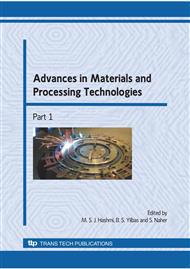p.113
p.125
p.133
p.143
p.150
p.157
p.165
p.174
p.182
Simulation and Physical Modeling of Forging Sequence of Bj Type Outer Race
Abstract:
The outer race of a constant velocity (CV) joint is an important automotive component that is difficult to be forged because its shape is very complicated and the required precision is high. Since traditional cold forging methods are not always capable of producing complexly shaped parts, such parts are often made by processes, which require intense machining operations at relatively high costs. Thus near net shape forging is an attractive option for producing of outer race. Actual problems in final ironing sequence are prevention of ductile fracture and surface defects in final product and true formation of internal ball grooves of the workpiece. In this study Cockroft&Latham failure criterion was applied to final ironing sequence. Finally physical modeling is down using lead. In order to investigate the flow of the billet material during forging, the experimentally obtained section profile of internal grooves as measured by a CMM is compared with simulation based profile.
Info:
Periodical:
Pages:
150-156
Citation:
Online since:
December 2009
Authors:
Keywords:
Price:
Сopyright:
© 2010 Trans Tech Publications Ltd. All Rights Reserved
Share:
Citation:


